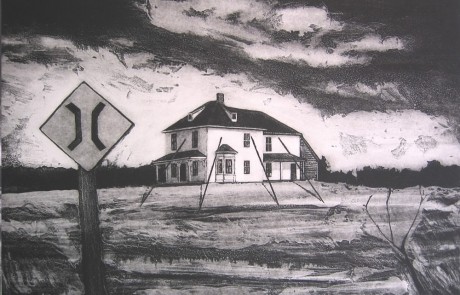Project Description
Who will guard the door when I am sleeping?
Hopewell Rocks, Bay of Fundy, New Brunswick
2006, Dan Steeves
intaglio print on paper
artist’s collection
THE ART
The Style
Dan Steeves’ image — Who Will Guard the Door When I Am Sleeping? — is an intaglio print, commonly called an etching. This printmaking style originated in Europe about five centuries ago.
Steeves draws the image onto a zinc plate, paints the plate with grease and then immerses the plate in nitric acid. The acid bites into the plate between the grease-coated areas, etching it with fine grooves or crevasses.
After sanding and polishing the plate to create tonal gradations, Steeves applies ink in the grooves and cleans the surface. He covers the plate with damp rag paper and passes both plate and paper through a printing press. Pressure forces paper into the grooves, pulling out the ink.
He repeats the process of drawing, etching, polishing and printing several times until the image is ready to print in edition.A black and white intaglio print relies on the delicate use of light and shade. It is ideal for revealing stratigraphic layers, fractures in rock and other subtleties of the geological landscape.
Without the distraction of colour, we can focus on the story told by lines and shadows.
The Interpretation
Few landscapes in New Brunswick are as well recognized or have been photographed so often as the Hopewell Rocks.
In “Who Will Guard the Door…”, Steeves has transformed the iconic view, moving it from clichéd tourist destination into the realm of unsentimental metaphor.
The title of the image mirrors the fact that The Hopewell Rocks are slowly being eroded by the ocean. The cliffs and sea stacks ‘sleep’through the eons while their foundations are worn away. Pebble by pebble, outcrop by outcrop, the rocks disintegrate into the Bay of Fundy.
Similarly, the cultural heritage of New Brunswick is being deeply challenged. As globalization grows, the province’s social and economic framework is shape-shifting in ways that so far remain unclear. In one sense, human events count as nothing on the geological scale, which measures time in millions of years. Yet we are here now, in this era. And here, many lives and communities—like the house in Steeves’ image—are perched between a rock (the past) and a hard place (the future).
Who will guard the door, indeed? But Steeves also wonders whether we guard ourselves too closely in the face of change. “How is it,” he writes, “that we build the house [our lives] into a … stronghold of security? A stronghold can, in the end, become nothing more than a paradox of isolation. …
Objects that exist in the landscape in time and space are thrown into disarray, an unsettling situation where some truth may be found.”
So what is the truth? Will cultural adaptations encourage us to re-imagine what defines us as a people? If so, how do we welcome change with grace but continue to protect our home and to recognize our soul?
Meanwhile, the Hopewell Rocks gradually erode away. And for each crumbling slope, a new rock surface emerges to face the rising Bay of Fundy sun. As ever, hope strolls hand in hand with change.


 Dan Steeves
Dan Steeves




